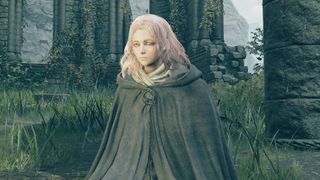Souls dataminer shows why Elden Ring's asset re-use is actually awesome
ZullieTheWitch has a great track record of finding out cool stuff in these games.

Elden Ring: in case you haven't heard, it's the bee's knees. One of the great and unexpected pleasures I've found in the game is seeing the echoes, large and small, of the Soulsborne games that led up to this point. When Elden Ring was first revealed its re-use of assets even became a silly controversy, with some sorts rather put-out that FromSoftware might, god forbid, re-use a perfectly functional sword swing animation rather than making a whole new one.
Thing is, Elden Ring is a masterclass in how to re-use assets, and this is arguably the only reason it exists in the form it does. The game is simply mammoth, and all players will have had these wild moments of taking an elevator or slipping into a cave and finding a whole new sprawl to search. FromSoftware has been building on this foundation since Demon's Souls (2009), and subsequently created five more games in a similar vein before Elden Ring. Every single one of them feeds into the Lands Between in some way.
Longtime Souls dataminer ZullieTheWitch is one of the most legit sources of information about these games out there: this is the individual who managed to create chalice dungeon glyphs that allowed players to fight unused bosses in Bloodborne. One of the things that's especially interesting about Zullie's work is they dig-out the unused stuff, which can often be in a near-final state, and each Souls title has its own assortment of what-might-have-been surprises buried in the code.
Zullie's posted a new video making a comparison that, I think, showcases the way FromSoft uses what it's got, and demonstrates why calling this asset re-use is really rather misleading. Asset re-use sounds like you just pick up a boss off a shelf and whack it in the new game. Whereas what FromSoft is doing in some cases, as the below demonstrates, is going back to stuff that didn't make the cut for whatever reason, and re-configuring it in a new form.
As the video shows, FromSoftware had originally intended to use this giant wolf boss in Dark Souls 3—in the end it was left out, but got far enough in development that Zullie had been able to make a previous video on it (and speculate it used a curved greatsword). FromSoftware ended up using the wolf model, however, to create the covenant statue in Farron Keep.
Elden Ring boss the Red Wolf of Radagon is this boss: except of course it's not. The base asset has been built-upon, little details like hair braids and earrings have been added, and it finally has its curved sword. Zullie doesn't mention this but the Red Wolf's moveset and brutal grace bear some resemblance to another cut boss, the Great One Beast from Bloodborne (which also used magic), and it may well be that the Red Wolf is an amalgamation of the two.
What this example shows in microcosm is that re-use is not only a lazy accusation, but a lazy term. This is more like revival.
The biggest gaming news, reviews and hardware deals
Keep up to date with the most important stories and the best deals, as picked by the PC Gamer team.
"There has been some grumbling about From Software's reuse of old assets, and I think it's been magnified somewhat by being one of the only meaningful complaints you can make against Elden Ring," writes Zullie. "I think it was a very responsible move by From Software, and all the better that they seem to have taken the opportunity to let us experience some bosses that failed to make it into their own game originally."
Responding to a question about Elden Ring's crabs, which use the same skeleton and animations as the crab from Dark Souls 3, Zullie sums up the only sane perspective on this: "I think it's perfectly fine for them to have done that though, since it's not like what makes a crab a crab is going to change much just because it's in a new setting."
The Red Wolf of Radagon is just one small example of what FromSoft did all across Elden Ring's world, which is making something old feel new again. The regions of this game feel unique because the designers have been able to draw on an enormous asset base built up over more than a decade, then build on top of it: rather than spending months building a new giant crab. Don't even get me started on what this does to the lore-heads: you'll never convince me that the snowy mountainous area with the giants isn't what actually lay through Demon's Souls 6th archstone.
Elden Ring recently received a giant patch that, among other things, addressed some of the performance issues affecting PC players, fixed certain NPC questlines that weren't working, and added NPC quest markers. There's still the odd glitch, of course, the current funniest being that the horse can be made to 'fly'.
Rich is a games journalist with 15 years' experience, beginning his career on Edge magazine before working for a wide range of outlets, including Ars Technica, Eurogamer, GamesRadar+, Gamespot, the Guardian, IGN, the New Statesman, Polygon, and Vice. He was the editor of Kotaku UK, the UK arm of Kotaku, for three years before joining PC Gamer. He is the author of a Brief History of Video Games, a full history of the medium, which the Midwest Book Review described as "[a] must-read for serious minded game historians and curious video game connoisseurs alike."
Most Popular






